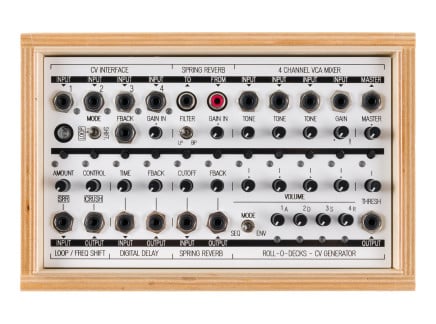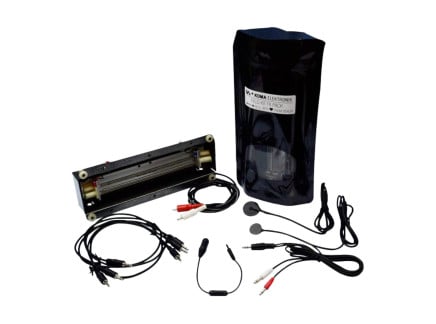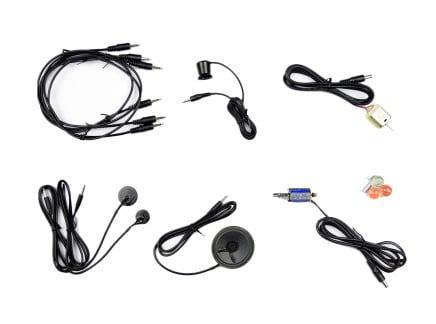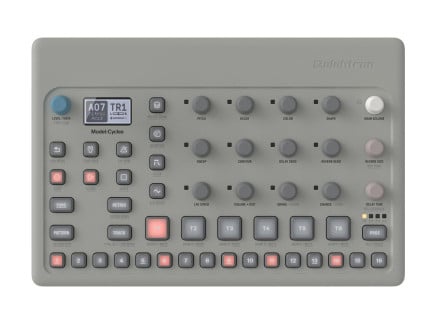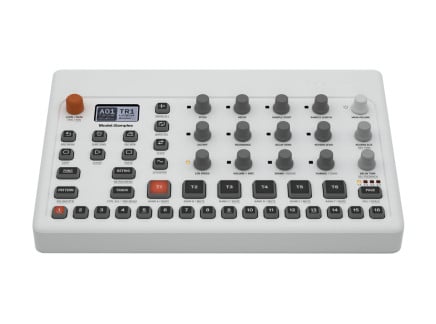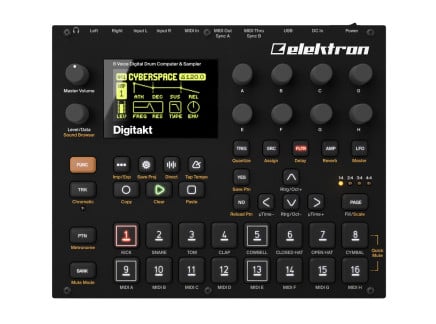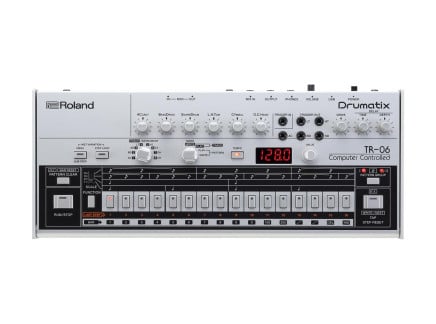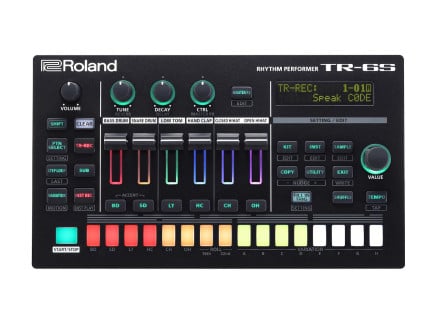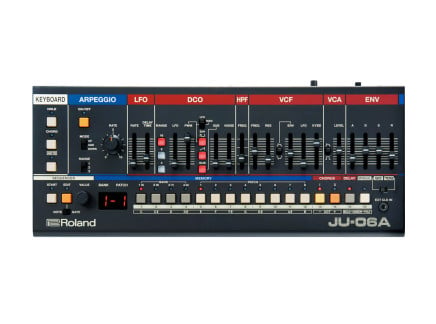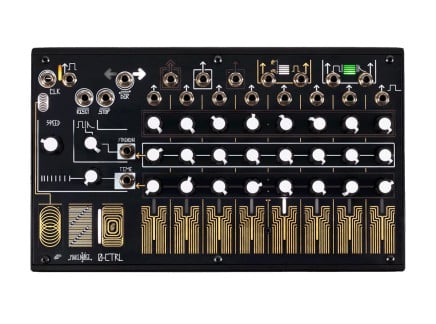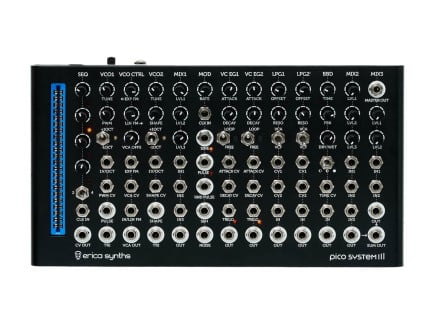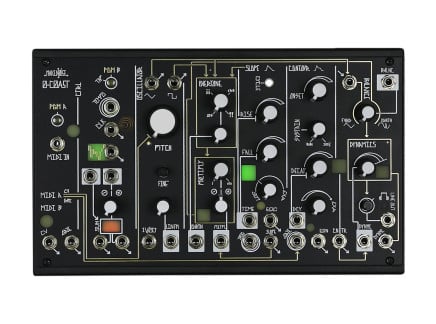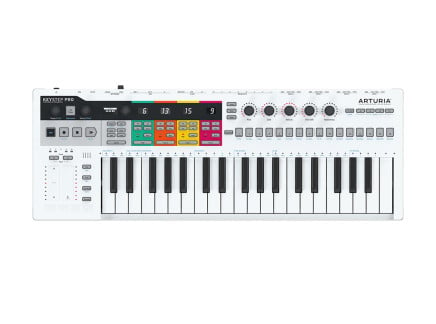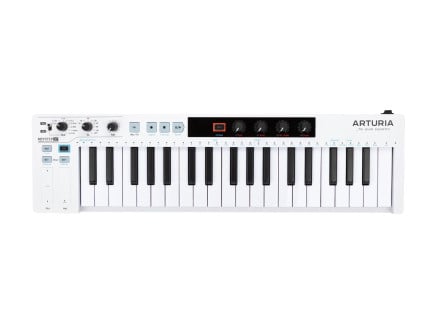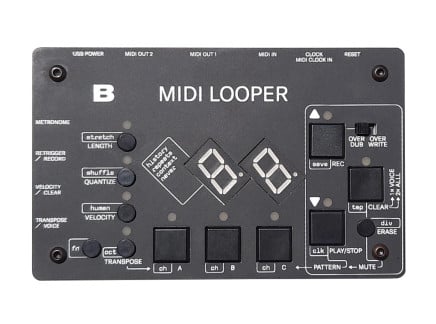Synthesizers and music production gear are more affordable than ever before, and now, it's possible to get some truly powerful and inspiring devices even under $500. So if you're on a budget and looking for the next addition to your setup, or if you're looking for a gift for a friend or loved one, don't fret—you'll be able to find the perfect thing without having to break the bank.
In a recent article, we discussed some of our favorite gear that you can get for under $200; but today, let's expand that range a bit and point out some of the most exciting deals to be found in the $200–500 range.
Powerful and Portable: Dreadbox Typhon
Dreadbox's Typhon hybrid synthesizer, which launched earlier this year, combines the Greek company's penchant for thick analog sounds and Sinevibes's ethereal, high-quality DSP effects. The first batch sold out across the globe, but they've reappeared just in time for the holidays.
The Typhon is a serious synthesizer in a small package—its analog synth engine is streamlined on the front panel, giving immediate macro-access to filter cutoff, envelope depth, and oscillator signal routing. In other words? All the controls you'll want to wail on when you're playing it.
Paired with this great-sounding analog synth is a vibrant stereo effects engine from Sinevibes that features over 14 unique and high quality reverbs, disortions, delays and more that can be chained together to create pedal-board-like combinations for endless fun. What makes the effects even more enticing is the fact that you can easily run an external signal into the Typhon and use its analog filter and built-in effects on other gear, making it one of the most powerful portable effects processors in its price range.
The Typhon is also equipped with a 32 step sequencer that boasts probability, glide, and MIDI note recording, as well as three enormously flexible modulator tracks that enable you to send LFOs, randomness, or envelopes to virtually any parameter on the Typhon. These features enable the Typhon to be a completely standalone instrument, making it an ideal companion for anyone on the go, or for someone who has smaller spaces to work in.
The Typhon seems like it has a little bit of something for everyone—it could be your new favorite effects processor, standalone analog synthesizer, or a powerful portable sequencer. It's endlessly flexible, and Dreadbox have been tirelessly working to add even more features to the Typhon as time goes on. In fact, since its release, they’ve already added four new effects engines and sequencer functions, and have more updates announced that should keep them busy well into 2021. Our most anticipated feature is audio over USB functionality, which will allow the Typhon to work as a rudimentary sound card, as well as open new possibilities for tablet based setups.
Exploratory Effects: Koma Field Kit / Field Kit FX
For DIY enthusiasts, circuit sniffers, and generally curious folks the Koma Field Kit and Field Kit FX are guaranteed hits. These two portable electro-acoustic workstations are chocked full of wonderfully flexible and fun tools that can inspire anyone to experiment with sounds and objects around them in new and interesting ways, and a perfect excuse to break up the tedium of quarantine! Though not new, these are still a blast and well worth a look.
In the flagship model, the Field Kit, you'll find a CV controllable AM/FM/SW radio, interfaces for sensors, switches, DC and solenoid motors, a mixer perfect for piezo microphones, and a handy manual titled "50 Ways to Use the Field Kit"—and at over 100 pages, it has a wealth of information on using, or abusing, your Field Kit. The Field Kit is designed in such a way that all of the available tools interact together in fun and interesting ways. So use a piezo disc and a jar full of sand to create strange white noise, or scan through the radio with the help of sensors, use a solenoid to tap on cans or send marbles plonking around in a shoe box...the possibilities are only limited by your creativity and whatever's laying around in the immediate area that can make noise!
This system of using electric devices to amplify and manipulate naturally occurring sounds to create new ones is inspired by Musique Concrète, a technique of composing sounds born out of the ingenuity of early sonic explorers who used tape loops, found sounds, and musical objects to push the boundaries of sound and music. And as a logical extension of this inspiration, Koma followed up the Field Kit with a new model based entirely around manipulating your sounds even further, the Field Kit FX.
While the original Field Kit focused on finding and creating sounds, The Field Kit FX allows you to process and manipulate sounds that you discovered. It features several effects that are able to reshape and re-contextualize almost any sound it encounters. Loopers, delays, frequency shifters and mixers are all at your disposal to mangle and modify anything and everything around you, and a handy CV interface allows you to send control voltages anywhere throughout the system. The Field Kits both complement each other wonderfully when combined, and due to their small size they can be packed up and taken anywhere from a walk down to the woods, or maybe just from the living room to the kitchen if you're not feeling so adventurous.
You don't even have to be a DIY type of person to take full advantage of the Field Kits, as Koma also offers "Expansion Packs" that feature prepared piezo discs, motors, sensors, spring reverbs and more! If you’re at all confused on how motors, and marbles add up to music, or just want to see these Field Kits in action check out how much fun we had with a big wrench and some other stuff we had laying around.
FM Groovebox: Elektron Model:Cycles
Model:Cycles from Elektron is an FM groovebox that delivers a range of sounds, with both drum and tone-based algorithms. Using an inventive approach to FM synthesis, the Model:Cycles can produce drum tracks, bass lines, melodies, and chords with ease—making it great for everything from ambient soundscapes to heavy-hitting drum patterns. It breaks out of the menu diving paradigm often implemented on Elektron devices for direct hands-on control over the parameters. Instead of being able to edit every single parameter, Elektron opted for a stripped-down interface with one knob per function. These dedicated hands-on controls lend themselves to performative and expressive playing. An LCD screen gives direct visual feedback of the parameters you're currently editing with values and neat glyphs for each parameter.
The six onboard FM algorithms with 64 factory presets give users a jumping-off point to start laying down sequences. These algorithms include Tone, Chord, Kick, Snare, Metal, and Perc, each with a specific sound and character. These are monophonic, except the chord mode. Get full control over everything from pitch to delay and reverb send to a volume control that distorts as you push the control to the upper regions. In addition to the global controls, each algorithm has four macro controls that are algorithm-dependent. These range from FM ratio to chord inversion to additional modulation envelopes.
Six velocity and pressure-sensitive pads select the active channel and/or play the corresponding voice. One great thing about the velocity sensitivity is that it is freely assignable to the sound and sequencing parameters. This allows for velocity-dependent control over everything from delay send to envelope decay to retrig multiplications. The retrig lets users play a repeating burst of notes while pressing on a pad with adjustable rate. An LFO adds automated parameter modulation with flexible routing, depth, and waveform controls.
Create sequences up to 64 steps long per track with adjustable length and speed scaling, from a 1/8 to x2 of the master tempo. Not only can you sequence the timing and pitch of the sounds using the sequencer, but automated per step parameter sequencing. Add swing, probability, or trigger conditions to the sequencing on a per step or per sequence basis. In addition to sequencing parameters, add per-step preset sequencing with up to 64 presets per sequence. Save and recall 96 projects with 96 patterns arranged in six banks of 16 patterns. Link multiple patterns together to create extended patterns and even songs.
The sequencer pads double as chromatic keys, useful for re-pitching the algorithms. However, if you want to really play the Model:Cycles, I suggest getting a dedicated MIDI keyboard or controller. The MIDI connections are on 3.5mm TRS jacks with MIDI in and out/thru. You can also connect to your computer via USB and record directly into your DAW of choice without a separate USB audio interface. While possibly not as powerful as some of Elektron's impressive lineup of other synthesizers, this FM groovebox fills a specific niche. It's portable and powerful, packing a ton of features into a small footprint. These have direct and playable controls that make it fun to jam on. Elektron announced plans for a handle/battery compatible with the Model:Cycles and its sibling, the Model:Samples. This will add a new level of portability, letting you take your music wherever you go.
Groovebox and Drum Computer: Roland TR-6S and TR-06
Roland is known for its grooveboxes and drum machines, making a name for themselves with a wide range spanning 40 years. Their TR-606 drum machine, with its companion bass synthesizer, the TB-303, was originally made for bass and drum backing tracks for guitarists. They did horribly at this.
However, these compact music machines helped revolutionize electronic music and, more specifically, the acid house genre. But it was not limited to one genre, with artists from many backgrounds picking up the drum machine that found its way into many pawn shops. The small size and ease of use of the TR-606 made it a hit with countless artists who loved its distinctive analog drum sounds. The TR-06 takes this legacy and runs with it, breathing new life into this much-loved drum machine. Roland revised the form factor, fitting in with their boutique line of synthesizers, and upgraded the build quality to 2020 standards.
One of the most significant improvements of the TR-06 is the ability to modify the onboard sounds. The original lacked any kind of sound customization outside of the individual level controls. While many artists ran the drum machine into external effects to sculpt the sound to their liking, on its own, the sounds get a little stagnant over time. Roland's Analog Circuit Behavior provides authentic-sounding analog drum voices with the flexibility of digital synthesis. Control the pitch, decay, and panning for each track to get the sound you want. Then add the onboard effects for additional sound shaping from the compressor, delay, and overdrive.
The sequencer retains the easy-to-use interface but adds new features that increase the drum machine's flexibility and usability. Pepper in some ratcheting, step looping, and even per-step probability to your sequences to make them come to life. Five trigger outputs and a trigger input provide a great way to integrate the TR-06 with your Eurorack or semi-modular devices.
The TR-6S, on the other hand, takes more inspiration from the TR-8S drum machine from Roland. This little sibling takes the powerful sound library and sequencing options and shrinks it down to a portable, six-track size. Using the same powerful ACB found in the TR-06, it recreates classic drum machines such as the 909, 808, 707, and 606. On top of that, Roland included an FM engine with 66 tones for wild percussion and bass sounds not found on many drum machines. Load up your own samples from an SD card and mix them in with any of the drums for even more sonic possibilities. Select any of the sounds with the buttons and alter the tuning, decay, and an assignable CTRL knob. Take any of those sounds and morph them with the extensive library of effects, including EQ, compression, delay, and reverb.
Load up any of the 128 drum kits and start laying down beats. The sequencer is the classic TR sequencer with 16 pads that correspond to sequencer steps. Add substeps with ratcheting up to four ratchets per step. The motion control parameters on a per-step basis help make even more dynamic sequences. Use the step loop function to loop a single step or multiple steps by holding them down while the sequence plays. The TR-6S is a fully class-compliant USB audio/MIDI interface, making it easy to store all your songs and patterns.
Both of these devices are portable, both in their form factor and the ability to be run off batteries. Roland takes inspiration from their older devices while still retaining an eye for the future. They update and innovate, bringing the best parts of new technology with time-tested methods. Both of these powerful devices fit a wide variety of applications with flexible sequencing and sound possibilities.
Modular Companion: Make Noise 0-CTRL
0-CTRL is an analog stand-alone sequencer from Make Noise that is inspired by the early capacitive touch controllers and sequencers by Don Buchla and Serge Tcherepnin, including the highly-revered MARF, TKB, and others. An outgrowth of Make Noise's own Pressure Points and Brains modules, 0-CTRL is a long-awaited missing link for the brand's excellent semi-modular synth 0-Coast (which in itself is another excellent option for gear under $500), and there are certainly some aspects of the design that truly make them best friends. However, the sequencer's overall compatibility with Eurorack signals makes it so much more than a dedicated controller for 0-Coast, rendering it a great candidate for a centerpiece in a variety of setups. So if your setup revolves around a modular system, desktop semi-modular synths, or anything else with CV/Gate inputs, the 0-CTRL will no doubt make a fun and inspiring addition to your rig.
0-CTRL is an eight-step sequencer, however, this limitation in length can be quickly overturned through a series of non-linear behaviors (programmed by self-patching within the sequencer), as well as real-time interaction with the sequencer's eight touch plates and other parameters. You can easily change the number of active steps, the starting position of the sequence, or the sequence direction on the fly simply using your own touch and/or gate signals. There are three control voltage outputs shaped by the positions of the three rows of parameter knobs. And while these can, of course, be sent to any modulation destination, it's easiest first to conceptualize these as corresponding to pitch, strength, and time. While the pitch parameter is self-explanatory, the other two perhaps need a little more clarification.
Strength defines the amplitude of a dynamic gate signal and built-in simple envelope output, which is perfect for opening LPGs and VCAs. The time parameter lets you alter the length of each step independently, which opens up a lot of potential for making anything ranging from custom swing to evolving and unpredictable generative sequences. It is important to note that time control affects the global clock output which can be used further to sync up your other gear to the unique feel you dialed in on 0-CTRL. Of course, the coupling of the bottom two sequencer rows to these parameters can be defeated, but using them even in this context alone can lead to a wide range of interesting, unexpected behaviors.
Being an analog sequencer, 0-CTRL additionally provides a few creative options that are inaccessible to digital sequencers. For example, the rate of the sequencer ranges from very slow all the way up to the audio range. This makes it possible to use the sequencer as a sound source in itself. Try syncing it to an external oscillator, and shape the waveform using parameter knobs.
This only covers so much of what 0-CTRL can do, and of course, there is much more to be discovered as you spend more time with this sequencer. And while it doesn't provide many channels and preset-saving found in the digital sequencers, it compensates for this through immediacy of workflow, and design that rewards creativity. If you are contemplating getting a portable interactive controller for your setup, this might be exactly what you're looking for.
Shape-Shifting MIDI Control: Sensel Morph
Selecting the right MIDI controller is never easy. One has to think in advance about what the controller will be used mainly for, whether it needs to have keys or pads, faders or knobs, or something more advanced like a multidimensional XYZ pad, or maybe even MPE compatibility? Well, the good news is that there is a device that to some extent has it all—Sensel Morph.
Morph is an adaptable multitouch controller that can change in appearance and behavior with a simple swap of a silicone overlay. The controller is designed to be flexible, and that means that it can seamlessly integrate into most workflows. That can be observed even from the selection of overlays Sensel offers. There is a music production overlay with a micro-keyboard, grid of pads, sliders, and knobs, a dedicated two-octave keyboard overlay, a drum pad overlay, a Buchla Thunder-inspired one, and these only cover music-centric overlays. You can also get a QWERTY-style tactile keyboard, overlays for video editing and gaming, and a customizable inventor's overlay. Morph recognizes its overlays very quickly, meaning that you can comfortably swap them mid-performance. Moreover, you can bypass the silicone overlays altogether and simply use the controller's multitouch surface by parsing the HID data it produces with software like Max/MSP, Pure Data, etc. Another important feature of Morph is its durability and its ability to withstand quite a bit of pressure, so you can use it with mallets too.
Morph's flexibility extends into its connectivity too. Like many other MIDI controllers, Morph connects to computers and compatible hardware via USB, however, it is also equipped with Bluetooth, and if your setup allows for it wireless MIDI, this is a compelling option. This makes it a great choice for mobile setups, as connecting the controller to your music apps via Bluetooth eliminates the need for adapters. Of course, if you need to connect it to hardware with DIN-style MIDI inputs, then using a MIDI-USB Host opens up the Morph to considerably broader territory.
While Morph is certainly not meant to substitute a keyboard, it certainly offers a new framework for interacting with electronic musical instruments. The silicone overlays are particularly suited for expressive articulations like slides, and vibrato enabled by Morph's MPE support. They may require a little getting used to, but what you'll gain is totally worth it. Altogether, it is a controller that fits perfectly for the traveling lifestyle and changing needs of many modern musicians.
Command Central: Arturia Keystep Pro
When it comes to the delicate balance of functionality and affordability, few controllers can top Arturia's Keystep. Both the original and the recently released 37-key variant offer simple but powerful sequencing capabilities and convenient connectivity options, including 5-pin MIDI, USB MIDI, CV outputs, and analog clock sync I/O. But given the long-standing success of their powerhouse Beatstep Pro sequencer, Arturia felt the keyboard-based sequencer paradigm could be pushed even further.
Practically bursting with features, the Keystep Pro offers a new perspective on the idea of the central controller keyboard. While just about any MIDI-capable keyboard will work great for controlling a wide range of software and hardware synthesizers, it's hard to find one that also boasts the same wealth of connections and a full-fledged sequencer built-in. All kinds of hardware instruments beyond traditional synthesizers, including drum machines, grooveboxes, Eurorack systems, and more, can now be seamlessly controlled from one place. With its four tracks of sequencing, each capable of up to 64 steps and 16-note polyphony per step, Arturia's tried-and-true sequencer workflow supporting polyrhythms, overdubs, and pattern chaining is wonderfully supplemented by all that Keystep Pro has to offer.
In a day and age where much of electronic-based music relies on some kind of sequencer, it's pretty significant to offer one this powerful in a controller with an abundance of output options. Besides the various MIDI outputs, each of the four sequencer tracks can be routed to any of the four CV output channels, with their own Note, Gate, and Modulation ports. While this effectively packs four of the original Keysteps into one controller, Arturia also borrowed the eight, rhythm-centric gate and trigger outputs from the Beatstep Pro. Despite the immediate assumption that the keyboard makes this strictly a melodic sequencer, it's easily adept at controlling a wide range of drum synths and percussively-curated modular systems.
Of course, you don't need a huge library of gear to get the most out of Keystep Pro's highly-capable sequencer. It works great as a general purpose MIDI keyboard and sequencer for softsynths and more, and even includes a controller mode with automation-style sequencing of MIDI CCs. Keystep Pro is a great fit for studios large and small.
A Brain for Your Whole Studio: Korg SQ-64
As modular synth enthusiasts, we were thrilled to hear about the recent announcement of Korg's new SQ-64 sequencer: a desktop device poised to offer central control for virtually any kind of electronic music setup. With the ability to connect to computers, MIDI hardware, and a whole host of CV-capable devices, the SQ-64 is sure to be great for modular artists, dance music producers, and anyone who needs to tie their setup together.
SQ-64 is, you guessed it, a 64-step sequencer. Each of the melody tracks (of which there are three) offers sixteen patterns of up to 64 steps each, while the drum track offers sixteen sub-tracks of 64 steps each. These can, of course, be manipulated in a broad range of ways—you can change the selected active steps, change sequence direction, and much more. And perhaps best of all, these sequences can be communicated to other gear in a variety of ways. Each track on the SQ-64 has its own MIDI channel and can be used to control gear via 3.5mm MIDI connections or USB—and in fact, the melody tracks are all polyphonic. The melody tracks also have three analog outputs: a CV, gate, and programmable modulation output that can be freely routed to any destination in your modular or semi-modular gear. The drum track offers eight gate outputs, perfect for triggering drum voices in your modular system or analog drum synths, or for triggering external modulation processes. It even includes Korg's standard audio sync in/out jacks, so you can easily synchronize it with Volcas, your old Monotribe, and other Korg gear.
Of course, there's more to this device that just straight-ahead sequencing. With creative sequence modes like reverse, random, and the esoteric "bounce" and "stochastic" modes alongside its ability to act as a keyboard-like MIDI controller, the SQ-64 is a heck of a bargain, poised to compete with long-standing favorites like the Arturia Beatstep Pro and others. If you're looking for a rugged, compact tool to tie your whole studio together, look no further than the SQ-64.
Creative MIDI Utility: BASTL MIDI Looper
Looping isn't a new concept in electronic music. From the early days of crafting tape loops through the development of early sequencers, and up to the modern day with DAWs like Ableton Live, clever manipulation of loops and repeated material is a viable method of music composition. Typically, we think of looping being done with previously captured audio material, and it will often be processed further through the use of effects, playback speed, overdubbing, and layering other loops to build compositions and apply variation to the same sonic motif. But because an audio file is effectively the final representation of that original sound, this begs the question—what about looping with MIDI? Historically this has been easily done in DAWs, but now Bastl's MIDI Looper offers a convenient hardware solution to this idea.
MIDI Looper does exactly what its name implies: it loops MIDI data. This offers some unique advantages over looping recorded audio in several ways, but the most immediate difference is that sound sources may continue evolving as the loop plays. For example, after recording a chord progression or arpeggiated sequence, one can easily continue adjusting parameters of the instrument to affect the sound, like changing oscillator waveforms, adjusting the filter cutoff or envelopes. Even better, change your synth's presets entirely to give the loop a new sonic identity, much like a composer moving a melodic theme across different families of instruments to convey different moods.
There's more to MIDI Looper than capturing note data though. Control Change messages can be recorded as well, offering looped automation potential. Additionally, there's a bunch of handy creative features built-in, such as the option for overdubbing, playback speed changes, transposition, velocity and rhythmic quantization, and more. Since MIDI Looper isn't working in the audio realm, it does not suffer from the same correlation of playback speed to pitch as an audio loop does (without employing the use of time stretching algorithms, of course), so any note transposition or tempo adjustments won't affect the other.
While standard synthesizers are the most immediate use case for MIDI Looper, it also works great with your favorite keyboard controller and a Eurorack modular system, so long as you have a MIDI-to-CV converter or module. MIDI Looper's built-in CV inputs for velocity, transposition amount, and retriggering offers the potential for unique musical development when paired with some kind of modular instrument.
Of course, there's no end to the list of inspiring and affordable gear—this is just a list of a handful of things that we've found fun and inspiring recently. But if you look further, you'll find that $500 can get you a lot in the modern world of music production...so whether you're into modular synths, drum machines, keyboards, or DAW production, no doubt there's something out there that is perfect for you.


